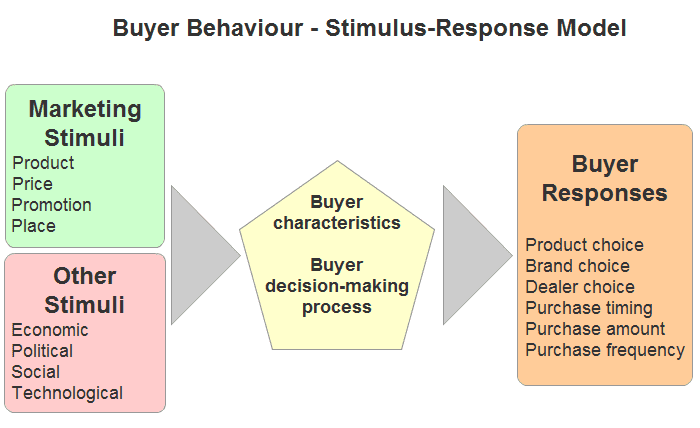INTRODUCTION
Marketing intelligence is an each day information applicable to a business firm's markets, collected and evaluated particularly for the motive of exact and assured decision-making for determination of market opportunities, market penetration strategies. It is specifically essential when a firm has to enter a foreign market (Liu and et. al., 2017). It identifies the intelligence required, gathers it through search in environment and provides it to marketing managers who require them. These systems gather data from different data sources such as web analytics, business intelligence, data of sales, call centre etc. The present study is going to throw light on the major stages of purchase decision-making procedure in context of Tesco. Along with this it is going to cover market research goals and customer satisfaction survey.
TASK 1
1.1 Main stages of purchase decision-making process
There are six stages of decision-making procedure taken by the consumers. As a marketer, Tesco can market it in an effective manner.
- Problem recognition: Before buying the customer should have a reason what they need, where they desire to be or how they see themselves or condition is different from where they really stand.
- Information search: When the problem is acknowledged, the process of searching starts by the customer (Jones, 2014). They understand that there is a problem and they try to solve it. The cited retail firm should establish its brand as a industry leader.
- Evaluation of alternatives: If the firm is standing out in the competition it does not assure that customer will surely buy its products or services.
- Purchase decision: At this stage, the customer has several choices, they know the prices and options for payment and they decide here whether to buy the product or not.
- Purchase: Now the requirement has been created, research has been done and the customer has decided to buy the product or service.
- Post-purchase assessment: Purchase has been done, it does not mean that the procedure has come to an end. After purchase, it is unavoidable that buyer should decide if they are happy and contented or not (Gabler Landers and Reynolds, 2017).
1.2 Buyer behaviour theories
The initial point to know behaviour of buyers is the stimulus response model. Marketing and environmental stimuli come in the purchaser's cognitive state. The characteristics and decision-making process of the buyer results in specific buying decisions. The task of Tesco is to know what is happening in the buyer's cognitive state of mind between the entering of outer stimuli and his buying decision (Buyer Behaviour: Stimulus-Response Model, 2017). The buying behaviour of the consumers is affected by factors such as culture, social and personal. Cultural factor exercise the widest and profound impact. They are the key determinant of buyer's needs and behaviours. Every culture comprises of small subcultures which offers more particular determination and socialisation for the members. The subcultures consists of national origin, religion, race and geographic area.Multicultural marketing emerged from careful research of market which reveals how different ethics and demographic places always does not responds favourably for mass market advertising. In virtual view, all human societies depict social stratification. Many time is takes the form of caste system in which people from various castes are given particular roles and they are not able to change their caste.Get the best coursework help at Assignment Desk.

1.3 Factors affecting behaviour of buyer
The buying behaviour of consumers are influenced by various forces with reference to Tesco which are elaborated here:
Psychological factors: The buying behaviour of customers is affected by several internal or psychological force such as motivation, perception. Motivation is a factor which sparks the goal inclined behaviour (Baumgartner and Weijters, 2017). Perception consists of many factors such as subjectivity, categorisation, selectivity, past experience etc.
Social factors: Human being is a social animal and their behaviour patterns, likes, dislikes are affected by the person around him to great level. These factors comprises of family, reference groups, roles and status in society.
Cultural factors: Behaviour of human beings it an outcome of the learning procedure and they grow up learning through a set of values, perceptions, preferences and patterns of behaviours. These forces include factors such culture, subculture and social class.
Financial factors: Behaviour of buyer is affected by economic forces. These factors include personal income, family income, savings, liquid assets, consumer credit and other factors.
Personal factors: These type of factors impact consumer behaviour (Katsikeas and et. al., 2016). The most essential factors that affect buyer behaviour are age, job or business, income and life style.
1.4 Brand loyalty, corporate image, repeat purchasing and their relationship
Brand loyalty is the dedication and loyalty of consumers for a particular brand. It depicts the want of the buyer to purchase that specific brand. They are purely engaged with brand they prefer. When the buyer like the brand to great extent, he or she do not tend to prefer any other brand.
Corporate image depicts the psychological image of the brand in minds of broader community. The stated firm Tesco creates a particular picture of its brand in the market which it then tries to prolong and grow for attracting the customers.
Repeat purchasing show when buyers purchases a product or service first time, and he is happy with the product or service and after that he buys that product or service again.These three terms are interlinked with each other. The mentioned firm employs several creative and effective techniques of marketing to develop a favourable corporate image in consumer's mind (Zhang and et. al., 2016). They get attracted towards it and purchases it. The first purchase is the exam of the product or brand. If it succeeds, the buyer purchases it again and also suggest it to his friends, family and individual around him.
TASK 2
2.1 Different types of market research techniques
The various forms of techniques for research in market are described in the below heads:
- Surveys: By concise, specific and straight questions, Tesco can evaluate a sample group which represents its target market. If the sample is large, the outcomes will be more reliable (Lindridge and Simoes, 2016). They can be in form of in-person surveys, telephone surveys, mail surveys, mail surveys and online surveys.
- Focus groups: With this type of technique, the firm can take use of scripted series of questions or subjects to do a discussion with a group of people. To receive balance outcomes, it can prefer at least three groups.
- Personal interviews: This technique consists of open-ended questions. They are generally for an hour and are usually recorded. They give subjective data and the outcomes are not reliable.
- Observation: The cited organisation can observe its customers in action by recording their videos when they come in the stores, or in their homes. It can see how they purchase the product or use that product.
- Field trials: To bring a new product or service in the stores to examine responses of buyers in real life selling situations can support the cited retail firm to make modifications, adjust prices, or enhance packaging.
2.2 Sources of secondary data
Secondary marketing research takes use of data which is already existing and has been gathered by some other person for another motive. Sources of secondary data can be from the firm Tesco itself and so it is called as internal secondary data. External secondary data is the data which is already published by other enterprises.Internal sources of data comprises of profit and loss statements, balance sheets, sales figures, stock records, past market research findings etc. When the secondary information which the organisation has gathered from the internal sources is not adequate, it can opt for external sources of secondary data (Nishikawa and et. al., 2016). These sources can be government sources, corporate filings, trade, business and professional institutions, media, broadcast, print media, internet,national and international institutions, historical data and information etc.
Marketing research objectives:
1.To make the customers happy and contented with the products and services offered.
2.To grow the market share of Tesco
3.To increase the brand image of the company.
4.To increase the number of customers.
2.3 Assessment of validity and reliability of market research findings
The mentioned retail company Tesco do not needs to undertake elaborate study of all its researches. But it must know that any kind of research done badly will not reap effective outcomes. Any study no matter how well it is controlled, has chances to be incorrect. There are several reasons why the study do not reap effective outcomes (Sheth, 2016). But mistakes must be identified with how data and information is collected.
The validity of the research can be assessed through many methods. The cited organisation which is examining the outcomes of the study can regularly ask a simple question: is the research computing what it is expected to compute? If the firm has any uncertainty with the answer for this easy question, then there are possibilities that outcomes are to be questioned.
Reliability is mainly concerned with assuring the ways of data collection leading to accordant outcomes. The firm has to ensure that research can be duplicated and may yield same output (Hamill, 2016). This is an essential component of scientific research method.
2.4 Marketing research plan
By taking out time to create a goal directed market research plan, Tesco can assure that iit is keeping its attention on high worth initiatives which will either provide good competitive position, enhance its link with its audience or both. The market research plan should consist of these areas:
- Brand awareness: This examines the customer's awareness of the products and services offered by the cited organisation. They are generally unknown and ask customers how known they are with their brand (McDonald and Wilson 2016).
- Target audience: The cited retail company cannot afford to target everybody. It has to know its target customers which will aid is creating applicable messages which resonates with them.
- Customers acquisition: To attract new customers, the organisation has to know what is making it tick. To conduct a survey of its ideal customers can prove great method of knowing how and why they prefer its brand (Andaleeb and Hasan,2016) .
- Customer retention: The firm should understand that it is inexpensive to retain present customer as compared to creating new customers. It has to do a market research for measuring customer satisfaction, grow customer loyalty.
TASK 3
3.1 Market size trends
A market is the place in which the customers make demand for specific product or service which can be fulfilled by business organisations. It usually comprises of present and prospective customers. Apart from customers, market includes retailers, suppliers, competitors, critics, middlemen etc.Quality assignment writing service available at Assignmenrt Desk.
Market size: Tesco has grown its market size of its grocery market with a regeneration of its supermarket brand range which is supporting to drive sales of fresh products. It is the only firm which has seen a growth. It market share increased from 28.1 percent to 28.2 percent year by year. Whereas its close rivals Sainsbury's, Asda, Morrisons all faced decrease in their market share. The sales volume of the company is increasing quickly, especially in the meat and fresh products sections. Sales of branded products did grown but most of the growth was due to its own labelled products, at inexpensive and superior prices.
Market trends: The retail industry has undergone immense changes in its structures over the last few years. The digital, e-commerce and technological advancements has caused several transformations in the retail sector of UK. The increase and utilization of digital and mobile technologies has resulted in a fundamental move in the manner consumers purchase and communicate with the retail companies of all size and type.
3.2 Competitor analysis
Tesco is a leading grocery firm in UK and retail company too whose key rivals are ASDA, Sainsbury, Morissons etc. that are often referred as the “Big Four” in the UK. The cited retail company also face competition from convenience stores that are increasing their popularity because consumer's preferences and tastes are moving towards more for few items (Martínez and et. al., 2016).
Tesco and Morisson:
Both the companies represents varied features in the grocery retail sector. As the cited organisation is the leading firm in the industry, its share price depicts how it can make its impact on the entire grocery retail market. Whereas, Morrison as follower of market may be unsafe for Tesco.
Tesco and Sainsbury:
Sainsbury is the third largest grocery firm in the UK having 1,304 locations. These locations are spread in half between supermarket and convenience stores. As per the customer surveys and reports on strengths of brand, it is the highest quality company among its colleagues.
3.3 Evaluating opportunities and threats for given product or service
The company hold a strong presence in 12 nations of Europe and Asia. For sustaining its position and create profits, it has to evaluate its strengths, weaknesses, threats and opportunities. For this purpose the grocery products of the company are being taken into consideration.
Strengths:The cited organisation is a strong retail brand across the globe, is is on the top of 100 world's most valuable brands. It is called as a organisation which provides value for money, broad range of products, comfort and locally inclined management.
Weaknesses: The profit of the firm has been influenced by bad debts from credit cards and high level household insurance claims.
Opportunities: There are ample of opportunities for the mentioned firm and its grocery products. It can expand its business in markets like digital entertainment. Additionally, expansion in overseas can take place in countries like Australia, where the grocery products market is having comparatively low competition and then also it is price sensitive (Alam, 2016).
Threats: The cited organisation is facing several threats in the market. The present position of the firm as number one in the grocery sector states that it is the target of accordant competition from Asda, Lidi, Aldi, Sainsbury. The threat which the firm tries to avoid and resist is the acquisition of Asda by Wal-Mart.
TASK 4
4.1 Techniques of assessing customer response
Customer response evaluation is collecting information from customers and identifying which reviews can be executed on the basis of Tesco's best interests. For this the company has to apply some techniques which are discussed here:
1.Home customer survey:
To asses the wants, desires, preferences and needs of the customers cited firm can use this technique (Berry and Berry, 2016). This consists of email surveys, mailed surveys, phone surveys etc.
2.Customer services questionnaire:
They are the brief surveys which customers take when they contact the customer services employee due to any problem. In this questions are asked to the customers about the complaints, by asking them to give views about their shopping experience and fill the questionnaire regarding the problems about the product.
3.Customers suggestions:
Many times it happens that customers give helpful suggestion of methods to improve services. The stated organisation can take use of these suggestions. They offer an opportunity for the firm to pay attention to their opinions and viewpoints.
4.Customer expectation:
The firm has to lay emphasis on responses made by every customer by assuring that changes are avoided on the basis of unfair and unjust requests (Lee Kim and Choi, 2016).
4.2 Customer satisfaction survey
The survey has been conducted to meet the objective of identifying the satisfaction level of the customers with the products and services offered by Tesco. For this a questionnaires has been prepared by taking sample size of 10 customers. This is a primary research conducted by the firm.
Age:
Gender: M/F
How many times do you use products and services of the firm?
- Once in year
- Daily
- Weekly
- Once in a month
- How much you are satisfied or dissatisfied with the products and services?
- Very satisfied
- Very dissatisfied
- Neither satisfied nor dissatisfied
- Partly satisfied
What terms you would like to use for the products?
- Reliable
- High quality
- Expensive
- Ineffective
To what extent does the products and services meet your wants and desires?
- Extremely good
- Not so good
- Very good
- Not at all good
What rates would you like to give for the quality of the products and services?
- Very high
- High
- Very low
- Low
What rates will you give for value for money of the products?
- Excellent
- Average
- Poor
- Above average
Would like to give any comments, questions, suggestions?
4.3 Review of success of survey
The survey which has been conducted for Tesco has proved effective in gaining information about the contentment level of the customer who are using its products and services. It has been learned from the survey that most of the customers prefer to use the products almost in a week or on daily basis. There are very few of them who prefer to use the product once in a month or year. The contentment level is very satisfied by half of the customers and half of them are only partly satisfied with the firm offerings. It has been determined that the products and services are meeting the needs and expectations of the customers to a great extent except a few. Most of the customer feel that the products and services provided by the firm are dependable with some of them saying that they are very costly. All the customers are have a common opinion about the quality of the product and that is very high quality. The customers gave many valuable suggestions, ideas in the comment box provided in the questionnaire. These recommendations and viewpoints will be given due consideration by the company while designing its marketing strategies. So, it can be concluded that the survey has been successful to a great extent as it covered all the necessary information to be gained.
CONCLUSION
The present report is made to assess the major phases in the purchaser decision-making process with reference to retail company Tesco. The study also elaborates the theories of buyer behaviour for which Stimulus response model is being evaluated. Further, the market research techniques such as surveys, focus groups, field trials etc. are applied in the cited company. The report also throws light on the SWOT analysis of the firm for its grocery products which has helped the firm to make further strategies for marketing of its offerings.
REFERENCES
- Alam, J., 2016. An analytical case study on existing corporate communication strategies of TESCO PLC, UK.
- Andaleeb, S.S. and Hasan, K., 2016. Marketing Research. In Strategic Marketing Management in Asia: Case Studies and Lessons across Industries (pp. 111-160). Emerald Group Publishing Limited.
- Baumgartner, H. and Weijters, B., 2017. Measurement Models for Marketing Constructs. In Springer Handbook of Marketing Decision Models.
- Berry, L.L. and Berry, L.L., 2016. Revisiting “big ideas in services marketing” 30 years later. Journal of Services Marketing, 30(1), pp.3-6.
- Gabler, C.B., Landers, V.M. and Reynolds, K.E., 2017. Purchase decision regret: Negative consequences of the Steadily Increasing Discount strategy. Journal of Business Research.
- Hamill, J., 2016. 17 The end of marketing as usual. The Marketing Book, p.415.
- Katsikeas, C.S., Morgan, N.A., Leonidou, L.C. and Hult, G.T.M., 2016. Assessing performance outcomes in marketing. Journal of Marketing, 80(2), pp.1-20.


 Company
Company













